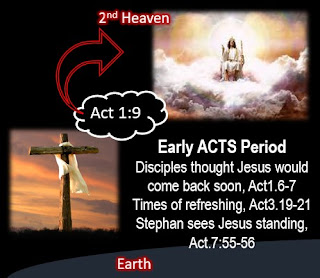The Stages of Christ's Ascension and Return (Part 2)
The Stages of Christ's Ascension and Return (Part 2)
 The Ascension of ACTS 1
The Ascension of ACTS 1

Acts 1:9-11 And when he had spoken these things, while they beheld, he was taken up; and a cloud received him out of their sight. 10 And while they looked stedfastly toward heaven as he went up, behold, two men stood by them in white apparel; 11 Which also said, Ye men of Galilee, why stand ye gazing up into heaven? this same Jesus, which is taken up from you into heaven, shall so come in like manner as ye have seen him go into heaven.
As mentioned in the opening post of this series, the ascension of Jesus in Acts 1 is only the beginning of Jesus departure back into glory. The bible provides us with much more insights if we study the scriptures and piece together additional verses that detail his return to heaven. The reason for putting focus on Jesus' ascension is not so much to learn what happened here as it is to provide insights into his glorious and soon return. There is so much more to know about His return, and since it mirrors His ascension (as Acts 1:11 suggests), learning about the ascension will bolster our understanding of His return.
Jesus was to come back quickly to save Israel
The disciples were fully expecting Jesus to return quickly again and to come and set up His kingdom, the inheritance of every Jews. Further evidence of this is found in Peter's inspired teachings in Acts 3,
Act 3:19-21 Repent ye therefore, and be converted, that your sins may be blotted out, when the times of refreshing shall come from the presence of the Lord; 20 And he shall send Jesus Christ, which before was preached unto you: 21 Whom the heaven must receive until the times of restitution of all things, which God hath spoken by the mouth of all his holy prophets since the world began.
In this verse it is clear that Peter was under the impression that Jesus would soon return. Although we know that this did not happen, and that it was not set in God's plan, we can deduce that if Israel did repent and believe in Jesus as their Messiah, Jesus could, and would have returned soon after His initial ascension.
It's also interesting to note the plural word, "times" in the above passage. Without being dogmatic, the word "times" is interesting and can allude to particular stages in the return of Christ and the setting up of His kingdom.
The last scripture I want to review is in Acts 7. Four years down the line we have the account of Stephen being stoned by unbelieving Jews. While he was being stoned, Stephen said the following,
Acts 7:55-56 But he, being full of the Holy Ghost, looked up stedfastly into heaven, and saw the glory of God, and Jesus standing on the right hand of God, 56 And said, Behold, I see the heavens opened, and the Son of man standing on the right hand of God.
The fact that Stephen saw the Lord is interesting and proves that Jesus had not yet moved into a higher state of glory. We will deal with this statement in the next lesson, but for now, this continues to verify our current point that Jesus had not ascending higher, but was waiting for Israel to respond to the final witness of Christ through the manifestation and ministry of the Holy Spirit at Pentecost.
I'd like to end this post with some clarity on three extra points of interest from the texts above.
ONE: Jesus was standing to do one of two things,
- If the Jews believed, He'd go back down to judge and set up the Kingdom.
- If Jews did not He'd ascend to the highest heaven until the appointed return time
THREE: The "the right hand of God", as in Acts 7 above, is not necessarily literal. It is seen as a place of honour and status throughout the biblical text. When the Bible makes statements that Jesus Christ sits at the right hand of the Father, it is affirming that he has equal status to the Father within the Godhead (Hebrews 1:3, 12:2; 1 Peter 3:22; Acts 7:55-56). The right hand of God, therefore, is a reference to both a place of proximity to God the Father and a position of power above all other powers.
In the next post, I will continue with the stages of Jesus' ascension, showing with scripture how He continued to ascend in glory into a place that man cannot see.



Comments
Post a Comment